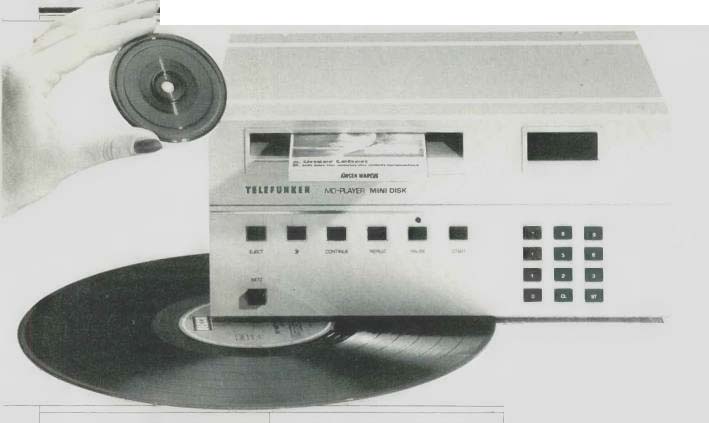by GARY STOCK

above: Telefunken's MD employs a simple approach to encoding digital information
on a disc surface, at a moderate price.
Observers of the Japanese electronics industry found an intriguing and puzzling item in the October 23, 1980 issue of Dempa Shimbun, Japan's leading electronics trade newspaper. An article quoted spokes men for the "DAD Committee," a government-sanctioned study group formed to make recommendations on a standard for digital audio discs, as saying that the committee had narrowed the field to three contenders. Two of those contenders were familiar: One was the optical 4 %z-inch diameter Compact Disc (CD) system developed by Philips and backed by Sony and Studer/Revox, among others; and the second Japanese Victor Company's Audio High Density (AHD) capacitance system, developed as a spinoff of the massive JVC videodisc development program. The third was a little-known "dark horse," backed by no one but its developer, that had been demonstrated to the DAD Committee for the first time a few days earlier on the 17th of October, Telefunken of Germany's MD (for Minidisk or Mikrodisk) for mat. Overnight, the MD format, which had previously been considered one of numerous prototype design exercises with relatively little commercial importance, acquired strategic significance to the world's major audio manufacturers.
MD is the product of a decade-long research project by Telefunken's and Decca's cooperative development wing, Teldec. Primarily the brainchild of noted Telefunken engineer Horst Redlich, MD employs a relatively simple mechanical approach to encoding digital information on the disc surface, in the interest of obtaining a moderate final price. According to the comments of Telefunken officials, one primary requisite for MD was that it have final hardware and software costs comparable to those for high-quality analog turntables and LP records.
The MD disc comes in two sizes, a 135-millimeter (5.3-inch) diameter Mini disk, which holds one hour of music per side in stereo, and a 75-millimeter (3-inch) diameter Mikrodisc, which is analogous to a regular 45-rpm single in terms of usage and holds 10 minutes per side in stereo. Both are enclosed in a cassette-type case, similar to the "caddy" used by RCA for its videodiscs, that pre vents groove damage or contamination; both are played in the same player. The transduction system, to put it simply, is a piezo-ceramic cartridge, equipped with a long cantilever assembly and a diamond stylus tip, that plays a vertically modulated (hill and dale) groove. The servo mechanisms needed to guide the stylus inward are considerably simplified by this spiral-groove arrangement.
Discs are mastered on a modified record-cutting lathe, in real time, using a copper master disc blank (the stylus is not heated; it produces a thin thread of copper as it inscribes the groove). A ridge arrangement at the center of the master disc provides automatic centering of the intermediate mothers and stampers as well as the final vinyl disc. A conventional record press can be used for pressing--even the disc raw material is identical to that used for LPs--and according to Telefunken, a press of conventional size can press either three Minidisks or six Mikrodisks .per cycle, thus bringing the actual production cost of a Minidisk below that of an analog record (at least until the unspecified cost of the cassette structure is added).
On the electronic side, the MD format uses a 14-bit linear encoding system, with fairly elaborate error correction, and provides a theoretical signal-to-noise ratio of about 85 dB--far better than analog--recordings but not quite up to the 90-dB S/N ratios of the JVC system and Philips Compact Disc. Like the Philips format, Telefunken's MD has a complete random-access system.
Philips has made a point in discussions of the Compact Disc of noting its suitability to automotive and other portable applications--an idea presently dismissed by some as not needed by the consumer, but one that will certainly be relevant 10 years from now when the format standards have been set and the technology begins to filter over to auto motive and budget equipment. Telefunken claims that MD can be made usable in portable systems as well, though the groove-contact format would not seem to lend itself easily to such applications.
No one really knows how good Telefunken's chances of being selected as the DAD Committee's favored system are, but most industry observers see it as the least likely of the three to be backed, despite the approach's demonstrated practicality and moderate cost. For one thing, Telefunken is not viewed as the preeminent trend-setting power among European electronics suppliers; Philips is, so most other European and British manufacturers are more likely to back a Philips-sponsored system, irrespective of its technical particulars, than one from Telefunken. Recent announcements by Sony officials that "more than 20" Japanese manufacturers had been signed up as Compact Disc supporters also seem to bode ill for MD's chances. (See this month's VideoScenes for particulars on Matsushita's prototype Compact Disc entry.) For the domestic Japanese market, VHD must be considered the odds on favorite to become the videodisc standard, and AHD's chances are there fore substantially enhanced by "coat tail" effect, especially since the same actual player would be used to play both VHD and AHD software. MD is clearly a brilliant, cost-effective design, but it may have come into the fray just a bit too late and with too few big-league friends to achieve supremacy. Its best shot at victory may be the traditional tactic for "dark horse" entrants in any competition--to be perceived as a reasonable compromise if the conflict between more powerful contenders becomes too protracted.
[adapted from: Audio June 1981]
Also see: